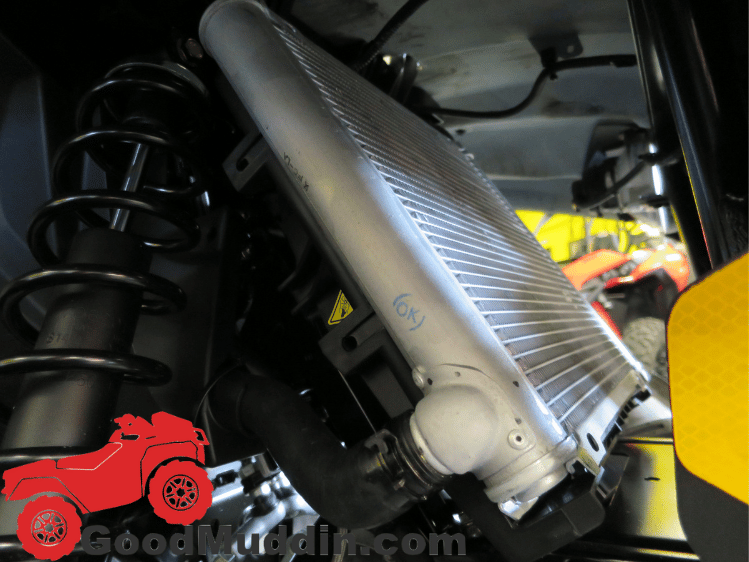An ATV can overheat for many reasons, but here are the most common symptoms.
- High temp gauge light.
- Steam or smoke.
- Odd smell, or it smells hot.
- Loss of power.
- Engine misfires or stalling.
- Check engine light.
- A ticking sound.
- Coolant dripping from the engine.
- Difficulty starting, especially after running for a while.
- A lot of heat coming from the engine and seat area.
A laser thermometer (ad) is always a good idea to carry with you on long rides, so you can not only measure your engine for overheating, but tires, bearings, and more.
You may get one or multiple symptoms when your ATV overheats. Let’s go over why your ATV’s overheating.
Why Your ATV Is Overheating
There are several reasons why an ATV may overheat. Here is a list of common factors:
- Low coolant or circulation – A low coolant level or a malfunctioning water pump can stop the cooling system from working right, leading to overheating.
- Clogged or dirty radiator – A radiator that is clogged with dirt, debris, or mud can obstruct the airflow needed for cooling your ATV.
- Fan or electric motor failure – The cooling fan, responsible for drawing air through the radiator, may fail due to a malfunctioning fan motor, debris stuck to it or electrical issues, resulting in poor airflow which leads to overheating.
- Thermostat stuck – A stuck thermostat can stop the engine from properly cooling. The thermostat doesn’t last forever, so make sure to test it if it’s been a few years.
- Overworking the engine – Continuous operation at high speeds, hauling heavy loads, running on hot days or pushing the machine beyond its recommended limits can strain the engine, generating a lot of heat and causing overheating.
- Poor air circulation – Low airflow around the engine caused by blocked vents, a damaged air intake system, or accessories in the way will lead to overheating.
- Oil issues – Insufficient oil levels or using oil that is of low quality or the wrong viscosity can overheat the engine due to poor lubrication.
- The elements – Extreme heat, high humidity, or operating in environments with limited airflow (such as deep mud or heavy vegetation) can increase the chances of your engine overheating.
- Engine problems – Issues with the engine, such as a damaged head gasket, a malfunctioning cooling system component, or a blocked exhaust system, can lead to overheating.
Not every quad overheats the same, some have better cooling and channels for better airflow. Some have better heat shields for the driver and passenger. Keep an eye on the display and other warning signs as you could miss the overheating as every ATV and side by side is different.
What To Do If Your ATV Is Overheating
If your quad is overheating, it is important to take quick action to prevent any more damage. Here are the steps you should follow:
- Turn the engine off.
- Allow it to cool off for 15 minutes or more.
- Check coolant levels after it has cooled down.
- Look for damage that may cause it to overheat, like mud on the radiator or damage radiator.
- Clean the radiator if it’s dirty.
- Make sure the radiator fans turn on when the engine is hot, they are usually noticeably loud when the engine is hot.
- Check oil level.
- Look for any leaking coolant.
- Consider the elements, if it’s hot, and you’re riding hard it could be just overworked and needs some time to cool down.
- Take it in to a repair shop if something is noticeably wrong.
Remember, safety should always be a priority. If you are unsure about any repairs or the severity of the overheating issue, it is best to talk to a qualified ATV tech or dealership.
How To Cool Down An Overheated ATV
Here are the steps you can take to cool down your overheated ATV and get you back riding quickly.
- Turn the engine off first.
- Allow it to cool down for at least 15 minutes, if not more.
- Open access panels or move accessories out of the way to get better airflow.
- Check coolant levels when cooled down, do not check them hot.
- Once cooled, rinse the unit off with some water to remove any dirt or mud that maybe blocking airflow.
- Once cooled and clean, restart the ATV and go easy to make sure nothing majorly is wrong.
- If it’s a hot day, and you’re riding it hard, try going slower and be less hard on the ATV.
Look For A Coolant Leak
If you’re refilling your coolant often, then you have a leak somewhere.
The cooling system on your ATV is a closed system, so it should not be using any coolant.
Be sure to check and follow any hoses connected to the cooling system for any damage, such as breaks, tears, and splits, especially around the exit of the hoses. Make sure all those hoses have clamps on them too and are not rusted.
Look all over the engine to make sure the gaskets are not leaking coolant or damage to the actual cylinders.
The coolant is often green in color, so it should be easy to see. Some ATVs do use an orange color coolant.
